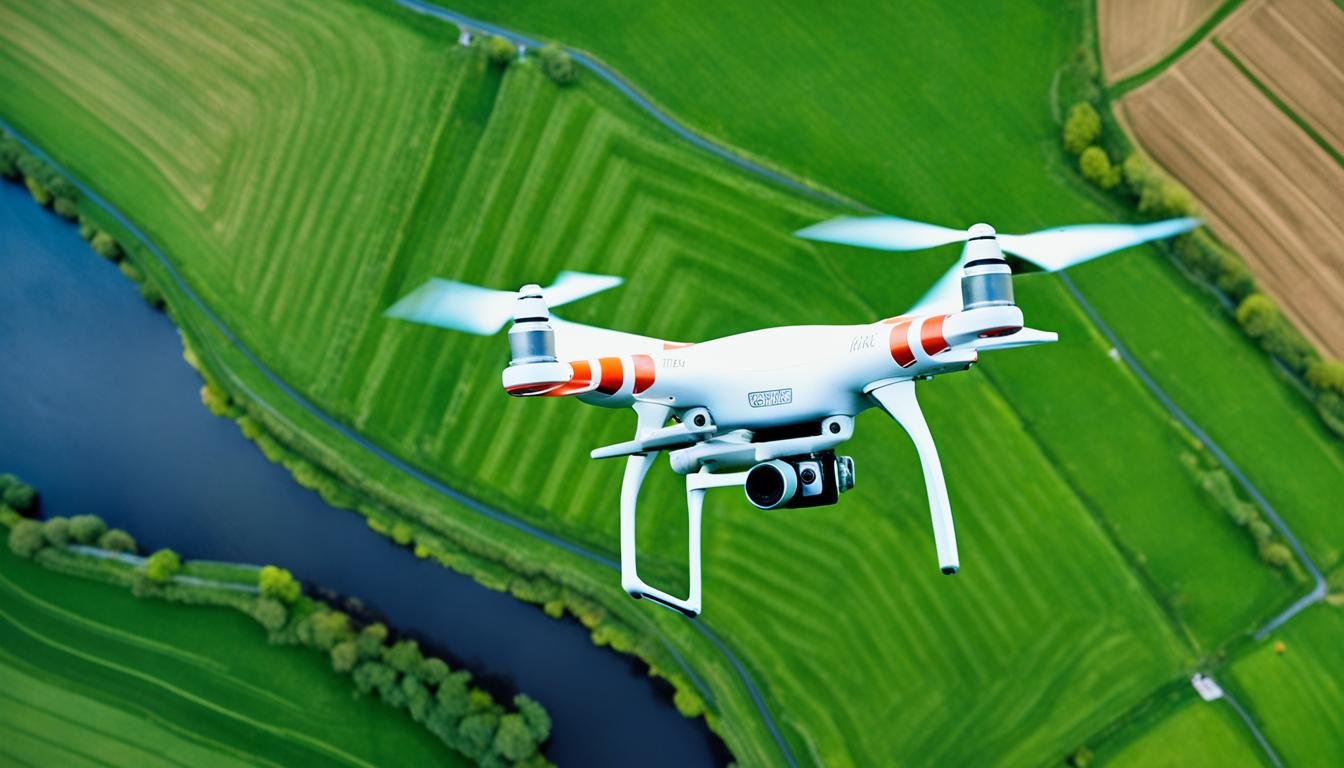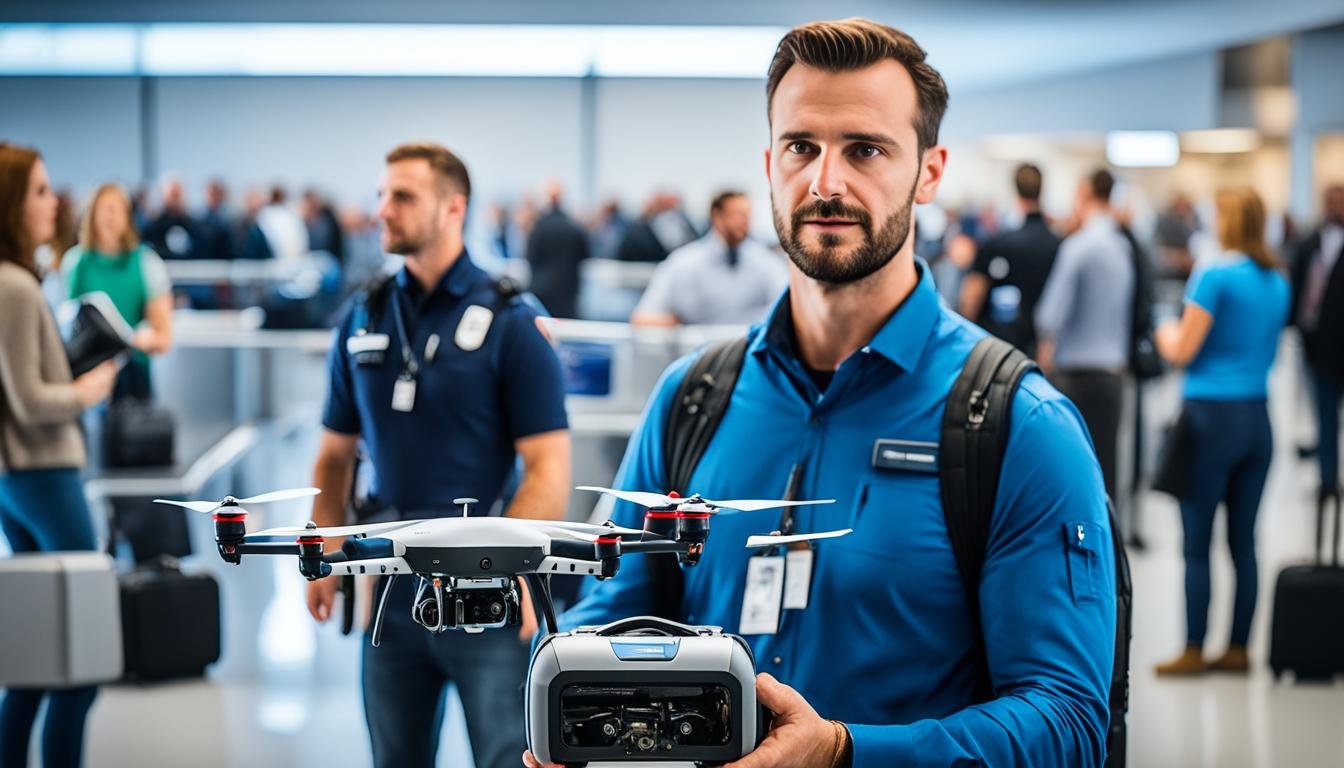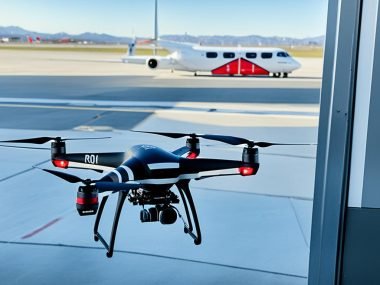In 2021, the UK had over 200,000 registered drones. This number shows many people enjoy recreational and commercial drone flying. But this raises a big question for both hobbyists and pros—are drones legal in the UK? My research shows that flying drones in the UK is legal. However, there are strict rules set by the Civil Aviation Authority (CAA). These rules are for safety and privacy in the airspace.
To use drones in the UK, you need to understand these rules well. For example, drones with cameras or those heavier than 250g must be registered with the CAA. You also have to pass a test to show you can fly safely. The complexity of UK drone laws shows that freedom to fly comes with a sense of responsibility and understanding.
Key Takeaways
- Drone flying in the UK is allowed, but you need to follow CAA regulations.
- There are strict rules about drone weight, cameras, and where you can fly.
- If your drone is over 250g, you must get a flyer ID.
- You need to know height limits and keep away from people and sensitive areas.
- Commercial drone users have to get permits and insurance.
- Drone pilots must keep up with new rules to stay legal.
Understanding UK Airspace Rules for Drones
As a drone fan flying in the UK, I always follow airspace rules closely. It’s not just to obey the law; it’s also to keep everyone safe. Knowing safe flying heights for drones in the UK is crucial.
Flying at Safe Heights: The 120m Limit
I make sure my drone stays below 120m (400ft). This rule helps avoid collisions with manned aircraft. It’s a safety measure because most planes fly much higher. All drone pilots should do this.
Maintaining Distance From Airports and Spaceports
Staying away from UK airports is key for me. Flight Restriction Zones (FRZs) around airports stop drones from interfering with planes. If I need to fly close, I get permission first. Not doing so can lead to big trouble.
The Critical Role of Air Ambulances and Military Aircraft
When flying my drone, I look out for military and air ambulances. They can fly below 120m but have airspace priority. I also watch for police helicopters when planning my flights.
As a drone pilot, avoiding busy airspace is my job. I use apps for real-time NOTAMs and airspace changes. This helps me fly safely and share the skies with manned aircraft.
| Aspect | Requirement | Consideration |
|---|---|---|
| Maximum Flight Height | 120m (400ft) | Buffer between drones and manned aircraft |
| Airport Proximity | No fly without permission in FRZ | Permission required to avoid legal consequences |
| Awareness of Low-flying Aircraft | Eyes open for air ambulances and military | Priority given to emergency and defense operations |
| Use of Airspace Apps | Active usage for live updates | Ensures compliance with NOTAMs and restrictions |
Understanding UK drone flying rules and respecting restricted areas is key. Each rule helps protect my drone and the community. Being a responsible member of the UK drone community means being safe and informed always.
Are Drones Legal In UK? Navigating the Regulations
If you love flying drones in UK, knowing the UK drone regulations is key. These rules help keep everyone safe, both in the air and on the ground. Let’s check out how your drone’s size influences where you can fly it.
Drone Dimensions: Impact on Legal Distances
The weight of your drone matters a lot for where you can fly. For small drones under 250g, you can fly closer to people, just 50m away. This is great for drone fans. But remember, flying over groups of people is a no-go, no matter the drone’s size.
Overflying People and Properties: What’s Permitted?
When flying over people or homes, UK rules are strict. Drones from 250g to 500g need a special certificate to fly close. And you must keep 150m away from busy places or groups, no matter what. This keeps everyone safe and respects people’s privacy.
| Drone Weight | Minimum Distance from People | Permit Requirement | Additional Restrictions |
|---|---|---|---|
| Under 250g | 50m (not directly over) | No A2 CofC needed | No overflight of crowds |
| 250g to 500g | Varies with A2 CofC | A2 CofC required for closer proximity | No overflight of congested areas without 150m distance |
| Over 500g | 150m from congested areas | Varies based on use | Strict adherence to drone permits UK regulations |
Keeping up with drone regulations is vital for anyone wanting to fly safely. By staying updated, you avoid breaking the rules. This helps keep the UK drone community vibrant and responsible.
Drone Registration Requirements in the UK
If you love drones, knowing the drone registration UK rules is key for fun and legal flying. Drones with cameras or heavier than 250g must be registered. Operators need to pass a test too. But, it’s not just the big drones that need this. Even small ones under 250g with a camera require you to register. This shows how serious the CAA is about keeping things safe and following UK drone law compliance.
Guidelines for Drone Operators From Abroad
Flying in the UK is full of chances for foreign drone pilots UK. But, international pilots can’t use their home permissions for UK commercial work. They must work with the CAA to meet UK safety rules. It’s critical to send in your paperwork early. This way, pilots from other countries can follow British laws without problems.
Renewal and Compliance: Keeping Up with CAA Standards
Following CAA standards for drones is an ongoing effort. Drone operators need to keep updated with new rules to stay legal. Renewing registration is part of this process. Doing so shows you’re serious about compliance. It also helps maintain your reputation among UK drone pilots. Let’s aim to keep our skies safe and follow the updates in UK drone law compliance.
Navigating Spaces: Where You Can Legally Fly a Drone in the UK
I love flying drones and have learned a lot about where it’s okay to do so in the UK. It’s crucial to know the legal drone flying areas in the UK. This ensures your drone flying is safe and legal, no matter the reason.
Assessing Flight Restrictions in Various Locations
In the UK, the rules for flying drones vary by location. Generally, you can fly drones in many places, especially if they’re under 250 grams. But, places like military bases and prisons have strict no-fly rules. Always check local rules and look out for changes during events or emergencies.
Commercial vs Recreational Drone Use: Different Rules?
For commercial drone regulations in the UK, the rules are stricter. If flying for work, like taking photos from the air, you need special permission. Whether flying for fun or work, knowing the rules and having insurance is crucial.
Let’s look at a table to better understand where flying drones in the UK is allowed. It helps to know this stuff to keep your flights legal and considerate.
| Area Type | Drone Weight | Recreational Use | Commercial Use |
|---|---|---|---|
| Residential/Industrial | Permitted with caution | CAA permission required | |
| Recreational/Green Spaces | Permitted with caution | CAA permission & insurance required | |
| Sensitive Areas | All Weights | Strictly prohibited | Strictly prohibited |
| General Airspace | All Weights | Adhere to all drone flight restrictions UK | CAA permission & insurance, adhere to regulations |
In summary, whether you fly drones for fun or work, the main advice is to stay updated. Always fly safely and follow the rules to protect our environment and skies.
Minimizing Risks: UK Drone Safety Guidelines
Knowing and following UK drone safety guidelines is key to safe and proper drone use. It’s important to consider the weather, respect privacy, and be ready for emergencies. Here, we will explore what every UK drone pilot needs to know for safe flying.
Weather Considerations and Flight Adjustments
Checking the weather impact on drone flights UK is crucial before flying. Since weather can shift quickly, staying updated and flexible is vital. Remember, various weather conditions like wind, fog, and temperature can affect how your drone flies.
Strong winds might mean flying further from people and buildings, or not flying at all. Being prepared to change your plans is important for everyone’s safety.
Respecting Privacy and Emergency Incidents
When it comes to drone privacy concerns UK, respecting privacy is a must. That means not flying over private areas or taking photos without permission. Always fly your drone in a way that keeps people’s privacy safe.
During emergencies or accidents, using drones requires extra care. Your drone should not get in the way of emergency teams. It’s important to follow any rules set during such times to keep everyone safe.
Securing Drone Permits UK: The Specifics of Operational Authorization
If you love drones, you’ll know that getting drone permits UK is key for business or riskier flights. In the UK, getting an operational authorization for drones UK is serious business. The Civil Aviation Authority (CAA) makes sure everyone is safe in the air and on the ground.
Starting your CAA drone authorizations journey means preparing important papers. You need flight logs showing your experience, an Operations Manual that explains how you do things, and insurance for surprises.
Let’s make the application needs clear:
- Flight Logs: These are records of your past flights, proving you’re safe and experienced.
- Operations Manual: This is your guide on how you handle flights and manage risks.
- Proof of Insurance: This shows you have insurance to handle any issues that come up.
After you apply, the CAA looks at your application carefully. They check if you meet all the safety and legal rules. Sometimes, they might ask for more details or suggest changes to your Operations Manual.
Fulfilling these permit needs shows you’re serious about being the best in drone flying. It’s about more than just following rules. It’s about setting high standards in the drone world, bringing new ideas to life while keeping everyone safe.
Drone Insurance: A Must-have for UK Operators
In the UK, following insurance rules for drones is crucial. If you’re flying drones commercially, not having strong drone insurance UK can cost you a lot if something unexpected happens. That’s why it’s so important to understand liability coverage for drones UK. With potential risks from flying drones, knowing your insurance details matters.
Insurance Obligations for Commercial Drone Use
Being a drone operator is more than just flying. It means knowing all about insurance too. One of the main drone operator insurance obligations UK is to have active coverage. This protects your business and shows you’re serious and responsible. This needed insurance helps cover damages to others’ property or injuries.
Understanding Liability Coverage
I’ve learned that understanding liability coverage for drones UK is essential for lawful flying. It covers me from damage or injury claims. With rules changing and skies getting busier, knowing my coverage details is key. It’s crucial for my operations.
For me, drone insurance is not just a checkmark. It’s a core need for my business. I’m focused on staying up-to-date with insurance to meet CAA standards and protect my business’s future.
The Impact of Size: UK Drone Regulations for Lightweight Models
Drones under 250g are getting popular in the UK. Many people are looking into UK drone regulations for lightweight models for guidance. These rules aim to keep everyone safe while allowing the use of lightweight drones. To fly these small drones, you must know not just the main laws but also the specifics of drone privacy laws UK and rules about flying drones close to people.
Beneath the Threshold: Drones Under 250g
The UK’s rules for drones under 250g are more relaxed compared to larger drones. They typically don’t need to be registered, which appeals to hobbyists and casual flyers. But, flying these tiny drones still requires being very careful to prevent accidents with people, animals, or property. This is why knowing about drones under 250g UK is key for a fun and safe flying experience.
Privacy and Proximity: Special Considerations for Smaller Drones
One might think small drones wouldn’t raise privacy issues. However, I believe in respecting privacy, and these drones can have cameras. They can unintentionally invade someone’s private space. So, knowing about drone privacy laws UK matters just as much for small drone operators. Anyone flying drones in the UK, whether in remote areas or nearby, must avoid violating privacy.

Here’s how UK rules vary by drone weight. This comparison shows different requirements for small and large drones, focusing on certification, privacy, and where you can fly:
| Drone Weight | Registration Required | Proximity to People | Privacy Considerations |
|---|---|---|---|
| Under 250g | No | Can fly closer to individuals but not over crowds | Must abide by drone privacy laws UK |
| 250g to 500g | Yes | Must maintain a safe distance unless the operator has an A2 CofC | Increased due to potential camera capabilities |
| Over 500g | Yes | 50m horizontal distance required from people | Significant due to higher chances of carrying advanced imaging equipment |
In conclusion, flying a drone in the UK, big or small, means following UK drone regulations for lightweight models. By respecting both safety and privacy laws, drone flying remains enjoyable for everyone. This way, drone enthusiasts can continue exploring the skies safely in the future.
Conclusion
In the UK, flying drones legally means knowing and following the Civil Aviation Authority (CAA) rules. My journey in understanding UK drone laws shows that it’s okay to fly drones. But, we must do so responsibly and safely.
We looked at everything from how high you can fly to needing to register your drone. Following these rules is key to flying drones in the UK. It’s not just about staying under a certain height or away from people. It’s about making safe flying a part of every flight and keeping up with the rules.
Drones and manned aircraft can safely share the UK skies. This is if I stay alert and well-informed as a drone operator. Whether flying a small drone or a larger one for amazing views, flying safely proves my dedication. It shows my commitment to safety, respecting others’ privacy, and my growing knowledge of flying.







